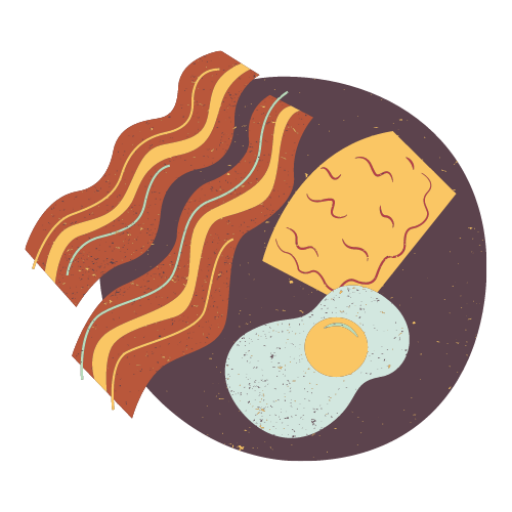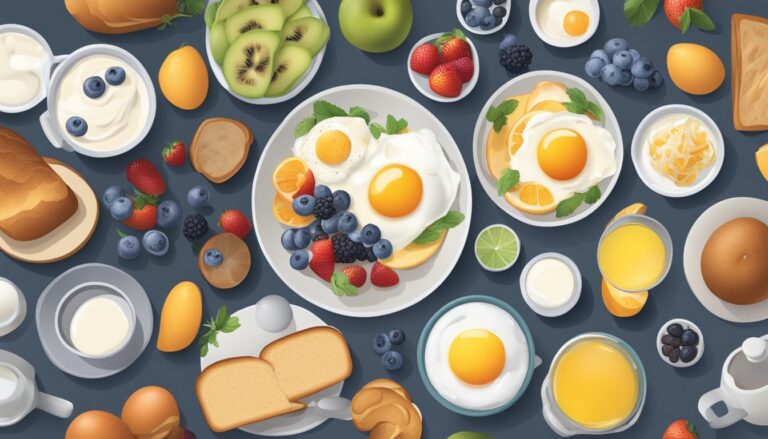Breakfast sets the tone for the day, providing essential energy and nutrients. For those mindful of their sugar intake, finding tasty yet low-sugar options can be a challenge. Many traditional breakfast foods are laden with added sugars, potentially leading to energy crashes and health concerns.
Fortunately, there are numerous delicious breakfast recipes that are naturally low in sugar. These recipes often incorporate whole foods, healthy fats, and protein sources to create satisfying meals without relying on added sweeteners. From savory egg dishes to creamy smoothies and crunchy granolas, low-sugar breakfast options can suit various tastes and dietary needs.
1) Avocado Toast with Poached Eggs
Avocado toast with poached eggs offers a nutritious, low-sugar breakfast option. This dish combines the creamy texture of ripe avocados with the protein-rich goodness of poached eggs.
To prepare, start by toasting whole grain bread until it’s golden and crispy. Mash ripe avocado and spread it generously on the toast. Season with salt, pepper, and a squeeze of lemon juice for added flavor.
For the poached eggs, bring water to a gentle simmer in a pan. Add a splash of vinegar to help the egg whites coagulate. Crack the eggs into the water and cook for about 3 minutes until the whites are set but the yolks remain runny.
Carefully remove the poached eggs and place them on top of the avocado toast. The warm, runny yolk creates a delicious sauce when broken over the avocado.
This breakfast is rich in healthy fats, fiber, and protein. It provides sustained energy without the need for added sugars, making it an excellent choice for those looking to reduce their sugar intake.
2) Chia Seed Pudding with Almond Milk
Chia seed pudding with almond milk is a nutritious and naturally low-sugar breakfast option. This simple dish requires just three ingredients: chia seeds, almond milk, and a touch of honey for sweetness.
To prepare, one combines almond milk with chia seeds and allows the mixture to sit in the refrigerator. The chia seeds absorb the liquid, creating a pudding-like consistency.
This breakfast is versatile and can be flavored in various ways. Popular additions include vanilla extract, cocoa powder for a chocolate version, or fresh fruit for natural sweetness.
Chia seed pudding is rich in fiber and protein, making it a filling breakfast choice. It’s also low in carbohydrates, fitting well into ketogenic or low-carb diets.
For those watching their sugar intake, using unsweetened almond milk keeps the sugar content minimal. Natural sweeteners like stevia or monk fruit can be used instead of honey for an even lower sugar option.
This pudding can be prepared in advance, making it an ideal grab-and-go breakfast for busy mornings. It can be topped with nuts, seeds, or a small amount of dark chocolate for added texture and flavor.
3) Greek Yogurt with Berries
Greek yogurt with berries is a nutritious, low-sugar breakfast option that combines protein-rich yogurt with naturally sweet fruit. This simple yet satisfying meal can be prepared quickly and customized to suit individual tastes.
To create this breakfast, start with a base of plain Greek yogurt. Greek yogurt contains less sugar and more protein than regular yogurt, making it an excellent choice for those watching their sugar intake.
Add a variety of fresh berries to the yogurt. Blueberries, raspberries, and strawberries are popular choices. These fruits provide natural sweetness without the need for added sugars.
For added texture and nutrition, consider sprinkling some nuts or seeds on top. Walnuts or almonds can provide healthy fats and a satisfying crunch.
If desired, a small drizzle of honey can enhance the sweetness without significantly increasing the sugar content. However, many find the natural sweetness of the berries sufficient.
This breakfast can be prepared in advance and stored in the refrigerator for up to five days, making it a convenient option for busy mornings. It’s also easily portable, perfect for enjoying on-the-go.
4) Vegetable Omelette

Vegetable omelettes offer a delicious, low-sugar breakfast option packed with nutrients. This versatile dish allows for endless combinations of vegetables, providing fiber, vitamins, and minerals.
To create a vegetable omelette, start with 2-3 eggs whisked together. Heat a non-stick pan over medium heat and add a small amount of oil or butter.
Pour the eggs into the pan and let them set slightly. Add your choice of chopped vegetables such as spinach, bell peppers, mushrooms, or onions to one half of the omelette.
Once the eggs are mostly set, fold the empty half over the vegetables. Cook for an additional minute or two until the eggs are fully cooked and the vegetables are warm.
For added flavor without increasing sugar content, sprinkle a small amount of cheese or herbs over the vegetables before folding the omelette.
Vegetable omelettes are naturally low in sugar and can be customized to suit individual tastes and dietary needs. They provide a satisfying and nutritious start to the day.
5) Whole Wheat Banana Pancakes
Whole wheat banana pancakes offer a delicious and naturally low-sugar breakfast option. These pancakes utilize ripe bananas for sweetness, eliminating the need for added sugars.
The recipe combines whole wheat flour with mashed bananas, providing a hearty texture and complex carbohydrates. This combination helps maintain stable blood sugar levels and promotes satiety.
Eggs and Greek yogurt can be incorporated to boost protein content. For a dairy-free version, alternatives like almond or coconut milk work well.
The natural sweetness of ripe bananas eliminates the need for syrup. A touch of cinnamon or vanilla extract can enhance the flavor profile without adding sugar.
These pancakes are versatile and can be customized with various toppings. Fresh berries, a dollop of Greek yogurt, or a sprinkle of nuts add nutritional value and texture.
Preparing a larger batch allows for easy freezing and reheating on busy mornings. This makes whole wheat banana pancakes a convenient and healthy breakfast choice.
6) Quinoa Breakfast Bowl

Quinoa breakfast bowls offer a nutritious and low-sugar start to the day. This protein-packed grain provides a hearty base for a variety of toppings and flavors.
To prepare, cook quinoa in water or milk until fluffy. Add a pinch of salt for enhanced taste. Once cooked, the quinoa can be served warm or chilled, depending on preference.
For added nutrition, top the quinoa with fresh fruits like berries or sliced bananas. These natural sweeteners eliminate the need for added sugars while providing essential vitamins and fiber.
Nuts and seeds make excellent additions, offering healthy fats and extra protein. Almonds, walnuts, or pumpkin seeds are popular choices that complement the quinoa well.
For those who prefer a savory bowl, eggs, avocado, and vegetables can be incorporated. These ingredients boost the protein content and add satisfying textures to the dish.
A dollop of Greek yogurt can provide creaminess and additional protein without significantly increasing sugar content. Spices like cinnamon or nutmeg can enhance flavor without adding calories or sugar.
7) Overnight Oats with Nuts
Overnight oats with nuts offer a nutritious, low-sugar breakfast option that’s easy to prepare. This versatile dish combines rolled oats, milk, and a variety of nuts for a satisfying meal.
To make overnight oats, simply mix oats with milk and refrigerate overnight. The oats absorb the liquid, creating a creamy texture without cooking. Adding nuts provides healthy fats, protein, and a pleasant crunch.
Popular nut choices include almonds, walnuts, and pecans. These can be chopped and stirred into the oats before refrigerating or sprinkled on top before eating. For extra flavor, consider toasting the nuts beforehand.
To keep the sugar content low, avoid adding sweeteners. Instead, rely on the natural sweetness of nuts and any optional fruits. Cinnamon or vanilla extract can enhance flavor without adding sugar.
For a protein boost, include a spoonful of unsweetened nut butter. This adds richness and helps keep you full longer. Experiment with different nut combinations to find your favorite flavor profile.
8) Cottage Cheese and Peaches

Cottage cheese and peaches create a delightful low-sugar breakfast combination. This simple dish offers a balance of protein, healthy fats, and natural sweetness.
To prepare, start with a base of creamy cottage cheese. Choose a low-fat or full-fat variety based on personal preference. The cottage cheese provides a rich source of protein to keep you satiated throughout the morning.
Fresh, ripe peaches are the star companion to cottage cheese. Slice a peach and arrange it atop the cottage cheese. The natural sugars in peaches complement the mild tanginess of the cheese.
For added flavor, consider a sprinkle of cinnamon or a drizzle of vanilla extract. These additions enhance the taste without introducing extra sugar. A handful of chopped nuts, such as pistachios or almonds, can add crunch and healthy fats.
This breakfast option is quick to assemble and requires no cooking. It’s ideal for busy mornings or when you desire a light, refreshing meal. The combination of protein from the cottage cheese and fiber from the peaches helps stabilize blood sugar levels.
9) Egg White Frittata
Egg white frittatas offer a protein-rich, low-sugar breakfast option that’s both versatile and satisfying. This dish combines beaten egg whites with various vegetables and seasonings, creating a fluffy and nutritious meal.
To prepare an egg white frittata, start by whisking egg whites until they become slightly frothy. Add salt, pepper, and garlic powder for flavor. Sauté vegetables like bell peppers, spinach, and cherry tomatoes in an oven-safe skillet.
Pour the seasoned egg whites over the sautéed vegetables. Cook the mixture on the stovetop until the edges begin to set. Then transfer the skillet to a preheated oven to finish cooking.
The result is a light, airy frittata that’s packed with nutrients and low in calories. One serving typically contains around 70 calories, making it an excellent choice for those watching their calorie intake.
Egg white frittatas are customizable, allowing for the addition of various vegetables, herbs, and even small amounts of cheese for extra flavor. They can be prepared in advance, making them ideal for meal prep and busy mornings.
10) Spinach and Feta Wrap
Spinach and feta wraps offer a savory, protein-rich breakfast option with minimal added sugars. These wraps combine nutrient-dense spinach with tangy feta cheese for a flavorful morning meal.
The base typically consists of a whole wheat tortilla or flatbread, providing complex carbohydrates and fiber. Fresh spinach leaves contribute essential vitamins and minerals while adding a vibrant green color to the wrap.
Feta cheese brings a creamy texture and salty flavor, complementing the mild taste of spinach. Some recipes incorporate egg whites or scrambled eggs for additional protein, helping to keep hunger at bay throughout the morning.
Sun-dried tomatoes or cherry tomatoes can add a touch of natural sweetness and acidity to balance the flavors. Herbs like oregano or garlic powder may be included to enhance the Mediterranean-inspired taste profile.
These wraps can be prepared in advance and reheated for convenience. They’re easily customizable, allowing for variations such as adding cucumber slices for extra crunch or using different types of cheese to suit individual preferences.
11) Smoothie with Kale and Pineapple

Kale and pineapple smoothies offer a refreshing, nutrient-dense breakfast option with naturally low sugar content. This vibrant green drink combines the earthy flavor of kale with the tropical sweetness of pineapple.
The base ingredients typically include fresh kale leaves, pineapple chunks, and a liquid such as water or unsweetened plant-based milk. A frozen banana can be added for creaminess and natural sweetness without excess sugar.
For extra nutrition, chia seeds or a tablespoon of nut butter can be incorporated. These additions provide healthy fats and protein, helping to create a more balanced meal.
Preparation is simple. Add all ingredients to a blender and blend until smooth. Start with less liquid and adjust as needed to reach the desired consistency.
This smoothie can be prepared ahead of time by freezing the kale, pineapple, and banana in individual portions. When ready to consume, blend the frozen ingredients with liquid for a quick breakfast.
The kale provides vitamins A, C, and K, while pineapple offers manganese and vitamin C. This combination creates a nutritious, low-sugar breakfast that supports overall health and provides lasting energy.
12) Whole Grain Waffles with Strawberries

Whole grain waffles with strawberries offer a nutritious and naturally low-sugar breakfast option. These waffles incorporate whole wheat flour and oats, providing fiber and essential nutrients.
The batter typically includes eggs, milk, and a small amount of oil or yogurt for moisture. A touch of cinnamon and vanilla extract enhances flavor without adding sugar.
Fresh strawberries serve as a naturally sweet topping. They can be sliced and placed on top of the waffles or pureed into a sauce. Strawberries add natural sweetness and vitamin C to the dish.
For extra protein, consider adding ground flaxseed to the batter. This also boosts the omega-3 fatty acid content of the waffles.
To prepare, mix dry and wet ingredients separately, then combine. Cook the batter in a preheated waffle iron until golden brown. Serve immediately with fresh strawberries.
These waffles can be made ahead and frozen for convenience. Simply reheat in a toaster or oven when ready to eat. This makes them a practical choice for busy mornings.
13) Buckwheat Crepes with Apples
Buckwheat crepes offer a naturally low-sugar breakfast option that’s both delicious and nutritious. These thin pancakes are made with buckwheat flour, which is gluten-free and rich in fiber and minerals.
To prepare the crepes, mix buckwheat flour with water, a pinch of salt, and optionally a small amount of oil. The batter should be thin and pourable. Cook the crepes in a hot, lightly oiled pan until golden on both sides.
For a low-sugar filling, sauté thinly sliced apples in a pan with a touch of cinnamon. The natural sweetness of the apples complements the nutty flavor of the buckwheat crepes perfectly.
Fold the warm crepes around the apple filling and serve immediately. This breakfast combines complex carbohydrates from the buckwheat with the fiber and nutrients from the apples, providing a satisfying meal without added sugars.
For added protein, consider including a dollop of Greek yogurt or a sprinkle of chopped nuts. These additions enhance the nutritional value and create a more balanced breakfast.
14) Ricotta and Honey on Rye

Ricotta and honey on rye bread offers a delightful low-sugar breakfast option. This simple yet satisfying dish combines creamy ricotta cheese with a touch of natural sweetness from honey.
To prepare, spread a generous layer of whole milk ricotta on a slice of toasted rye bread. Drizzle a small amount of honey over the ricotta for a subtle sweetness that complements the tangy cheese.
For added flavor and nutrition, consider topping with fresh berries or sliced figs. A sprinkle of cinnamon or a few chopped nuts can provide extra texture and taste without increasing the sugar content significantly.
This breakfast provides a balance of protein from the ricotta and complex carbohydrates from the rye bread. The honey adds just enough sweetness to satisfy cravings without overloading on sugar.
Rye bread, known for its dense texture and nutty flavor, pairs well with the creamy ricotta. It also offers more fiber than many other bread options, helping to keep you feeling full longer.
15) Tofu Scramble with Veggies

Tofu scramble with veggies offers a protein-packed, low-sugar breakfast option. This dish mimics the texture of scrambled eggs while providing a plant-based alternative.
To prepare, crumble firm tofu and cook it in a skillet with oil. Add nutritional yeast, turmeric, and spices for flavor and a yellow hue. Incorporate diced vegetables like bell peppers, onions, and mushrooms for added nutrition and taste.
The versatility of tofu scramble allows for customization with various vegetables and seasonings. Some recipes include garlic, spinach, or cherry tomatoes for extra flavor and nutrients.
This breakfast dish cooks quickly, typically ready in 15 minutes. It pairs well with whole grain toast or roasted potatoes for a satisfying meal. Tofu scramble provides a good source of protein and essential nutrients without added sugars, making it an excellent choice for those watching their sugar intake.
Nutritional Basics of Low Sugar Breakfasts

Low sugar breakfasts provide sustained energy without causing blood glucose spikes. They focus on nutrient-dense ingredients that keep you feeling full and satisfied.
Understanding Sugar Content in Foods
Natural sugars occur in fruits, vegetables, and dairy products. Added sugars are found in processed foods and sweeteners. The American Heart Association recommends limiting added sugar to 25 grams per day for women and 36 grams for men.
Reading nutrition labels helps identify hidden sugars. Look for terms like sucrose, high-fructose corn syrup, and dextrose. Whole foods without labels are generally lower in sugar.
Fiber slows sugar absorption, so high-fiber foods like oats and berries are good choices. Protein and healthy fats also help balance blood sugar levels.
Benefits of Low Sugar Diet
Low sugar diets can improve energy levels and mood stability. They may reduce inflammation and lower the risk of chronic diseases like type 2 diabetes and heart disease.
Cutting back on sugar often leads to weight loss and better dental health. It can also improve skin clarity and reduce acne for some people.
Low sugar meals help maintain steady blood glucose, preventing energy crashes. This supports better focus and productivity throughout the day.
Choosing low sugar options encourages consumption of more nutrient-dense foods, improving overall diet quality and nutritional intake.
Balancing Flavor and Nutrition

Creating low-sugar breakfast recipes requires careful consideration of ingredients and techniques. Natural sweeteners and whole foods can enhance taste while maintaining nutritional value.
Using Natural Sweeteners
Natural sweeteners offer a way to add sweetness without relying on refined sugars. Honey, maple syrup, and dates are popular options that provide flavor along with trace minerals and antioxidants. Stevia, a plant-based sweetener, contains zero calories and doesn’t affect blood sugar levels.
When using natural sweeteners, start with small amounts and adjust to taste. Mashed bananas or applesauce can add natural sweetness to baked goods while also contributing moisture and fiber.
Cinnamon, vanilla extract, and nutmeg enhance perceived sweetness without adding sugar. These spices can be particularly effective in oatmeal, yogurt parfaits, and smoothies.
Incorporating Whole Foods
Whole foods bring natural sweetness and essential nutrients to breakfast recipes. Fresh or frozen berries add vibrant flavor and antioxidants to pancakes, waffles, or overnight oats. Grated carrots or zucchini can be mixed into muffin batter for moisture and subtle sweetness.
Nuts and seeds provide healthy fats and protein, creating a satisfying meal without added sugars. Try sprinkling chopped almonds on yogurt or adding chia seeds to smoothies.
Whole grains like oats, quinoa, and barley offer complex carbohydrates and fiber. These ingredients help stabilize blood sugar levels and keep you feeling full longer. Experiment with grain bowls topped with fresh fruit and a drizzle of nut butter for a balanced, low-sugar breakfast.




